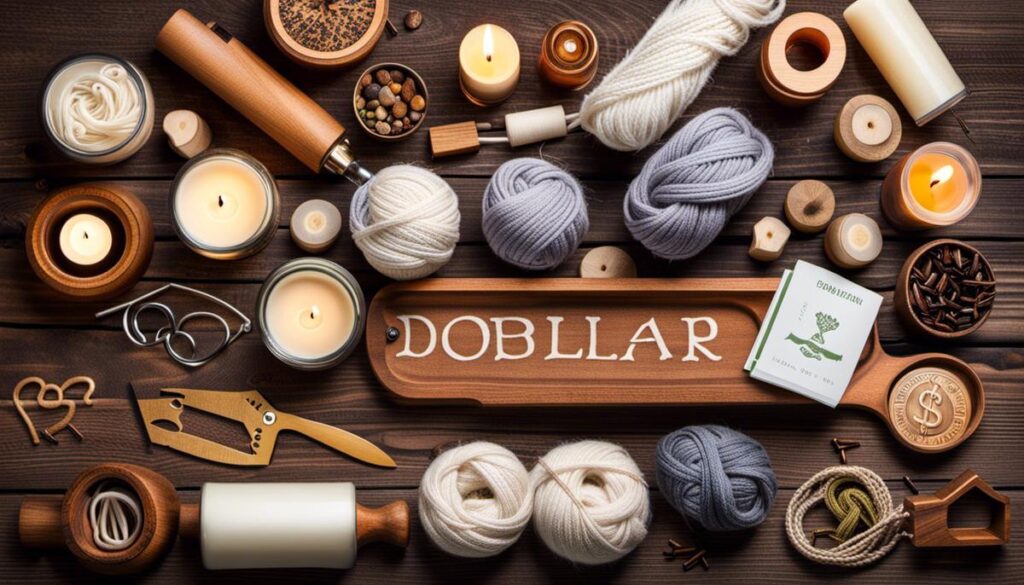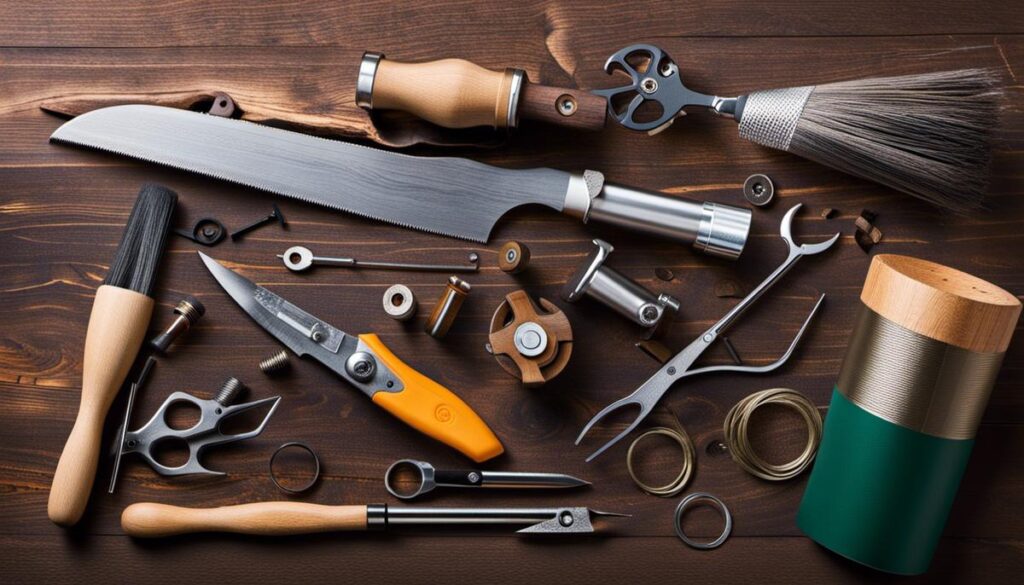In light of harnessing creativity and embracing entrepreneurship, the idea of exploring profitable Do-It-Yourself (DIY) hobbies is not only intriguing but also potentially rewarding. This encapsulates a diverse range of crafts, from woodworking, knitting, and jewelry making, to soap and candle making, among others.
Table of Contents
ToggleDIY Hobbies that make money
This discourse will delve into the intricacies of transforming your passion into a profitable venture. The focus will fall on aspects such as product creation, materials sourcing, price determination, and in-depth market analysis. Furthermore, we will investigate different platforms to sell your crafts, set up an online store, optimize product photography, and enhance your product descriptions.
Identifying Profitable DIY Hobbies
Identifying Your Interest in DIY Hobbies
The first step in choosing a profitable DIY hobby is to identify your interests and skills. Start by making a list of activities that you enjoy and things that you’re good at. This could include anything from painting and knitting to woodworking, jewelry making, and soap or candle making.
Once you’ve created this list, try to determine which hobbies have the potential to be profitable. For example, if you enjoy woodworking and are good at it, you might consider selling handmade furniture or décor items.

Researching the Market for Your Hobby
Next, research your potential market. Determine if there’s a demand for the items you would make and if people are willing to pay a price that would bring you profit. Look at online marketplaces, local stores, and craft fairs to see what similar items sell for.
This will also give you an idea of the competition. For instance, if there are already many sellers of handmade soap, you would need to find a way to differentiate your product.
Testing Your Hobby’s Profitability
Before committing to a hobby, test its profitability. Start by creating a small batch of products and selling them at a local fair or online. Track how much you spend on materials and how much time it takes to make each item. Then, compare this to the price at which the items sell. This should give you a rough idea of whether or not this hobby could be profitable.
Profiting from Your DIY Hobby
Once you have identified a potentially profitable DIY hobby, you can start to really get to work. Increase your production and start marketing your products more broadly. Use social media to showcase your work and connect with potential customers. Participate in local craft fairs and consider setting up an online store.

Eco-friendly DIY Hobbies
With an increasing interest in sustainability, eco-friendly DIY hobbies also have the potential for high profitability. Upcycled furniture, hand-woven baskets, cloth bags, and reusable beeswax wraps are just a few examples. People are willing to pay more for items that are unique, handmade, and also good for the environment.
Upskilling for Increased Profits
Finally, be open to learning new skills to increase your profits. For instance, if you’re into candle making, try learning how to make different types of candles or how to use different materials. The more skills you have, the more diverse your product range can be, which can serve to attract more customers.
Remember, the key to profitable DIY hobbies that make money is choosing something you love to do. This way, even if it involves a lot of work, it will still bring you joy – and hopefully some additional income, too.

Crafting for Profit
Recognizing Profitable Crafts
Identifying and zeroing in on crafts that make money is the first step to turning your hobby into a profit. Dive into market research according to your area of interest, say, upcycling furniture, candle making, or pottery. These crafts have high demand and good profit margins. It’s essential to understand what is trending, what materials are cost-effective, and what people are prepared to pay for handmade goods.
Sourcing Inexpensive Materials
Saving money on materials helps increase your profit margin. Buy in bulk and look for discounts at your local craft store. Alternatively, shop online at wholesale craft supply websites. Be on the lookout for items on clearance; they can be purchased cheaply and stored for future use. Another economical method for sourcing materials is using found objects or repurposing items.
Calculating the Cost of Your Craft
Determining the cost of your craft is crucial to establish a price for it. Calculate total material cost, time spent on creating the product, and overhead costs such as rent, software, or packaging. Ensure your priced goods cover these costs and leave a profit margin for you. It’s recommended to use a cost calculator to include variable factors.
Understanding Your Target Market
To set a viable price for your crafts, you must understand your market and your competitors. Survey similar handmade crafts and their prices on platforms like Etsy, eBay, and local craft fairs. This will give you an idea about the average pricing and the competition.
Pricing Your Crafts
To price your craft, consider the cost of materials, labor, overhead costs, and the market price. Don’t undervalue your time or skills. Align your price with the target market and competitive pricing but ensure that it covers your costs and profits. If the cost of creating an item is high, consider ways to reduce expenditure.
Marketing Your Crafts
Effective marketing is essential to generate sales. Utilize online platforms like Etsy, Facebook Marketplace, and Instagram for selling your crafts. Take quality photos of your products, write detailed descriptions, and use relevant tags and keywords for effective SEO. Also, consider creating a separate business website or blog for better reach.
Understanding Your Competitors
Knowing your competitors and the strategies they employ can provide insights for your business. Look at their product range, pricing strategies, and how they market their products. This will help you devise effective techniques to get ahead.
The key to success in crafting for profit is continuous learning, testing, adapting, and evolving. Each craft and market is unique, so what works for one may not work for another. Experiment with different strategies, keep a close eye on changes in trends and preferences and don’t be afraid to innovate. This will help turn your DIY hobby into a profitable business.

Selling Handcrafted Items
Choosing the Perfect Marketplace for Your Handcrafted Items
To get started, the first step is to determine the marketplace that aligns with your products. Various platforms like Etsy, Amazon Handmade, and eBay are popular places where artisans can sell their handmade items. Etsy, for instance, is known for unique and creative goods, while Amazon Handmade offers a platform for craftsmen to display their handmade products to Amazon’s large customer base.
eBay, on the other hand, is a global marketplace where anything, including handmade items, can be sold. Review each platform’s policies, fees, and demographics to choose the right fit for your handcrafted goods.
Setting up a Successful Online Store
Once you’ve determined a platform, the next step is to set up a successful online store. To do this, establish your brand. Create a memorable store name and logo, and keep a consistent visual aesthetic in your shop. This will help customers recognize and remember your brand.
Remember also to link your store to your social media platforms to drive traffic. Pay attention to keywords and search engine optimization (SEO) to make your store easily discoverable by potential customers.

Capturing Attractive Photos of Your Items
A picture is worth a thousand words, and in online selling, the quality of your product pictures can greatly influence buying decisions. Invest in a good camera or smartphone to take clear, high-resolution photos. Natural light is best for showing accurate colors, so photograph your items near a window or outside.
Make sure to take multiple shots from different angles. Simplicity is key, so use a plain backdrop to make your items stand out. For a more professional look, consider using photo editing software to enhance your product images.
Writing Effective Product Descriptions
A good product description should be informative, enticing, and straightforward. Start by identifying your target audience. This allows you to adjust the tone and language of your description to speak directly to them. Include details like dimensions, materials used, color options, and care instructions.
Highlight the unique features of the item and explain how it can benefit the buyer. Use SEO-friendly keywords to make your items more searchable online, but avoid jargon and be sure your description is easy to read and understand.
Promoting Your Handcrafted Items
To drive sales, consider various marketing strategies. Social media marketing is effective for reaching a wider audience. Share beautiful photos of your items, run promotional campaigns, engage your followers by starting conversations, and use relevant hashtags to expand your visibility.
You might also consider email marketing. Send newsletters to your customers featuring new items, sales, or exclusive discounts. Remember to always provide excellent customer service. Happy customers can become repeat buyers and may leave positive reviews that attract more customers.

Marketing Your DIY Hobby
Knowing the Basics of Marketing Your DIY Hobby
Successfully monetizing your DIY hobby involves quite a bit more than just crafting amazing products. Effective marketing plays an important role in transforming your hobby into a lucrative business venture. Understanding key marketing strategies such as SEO, social media promotion, email marketing, and leveraging influencer marketing is crucial to this process.
Develop a Unique Brand Image
Creating a unique and recognizable brand is the first step in your marketing journey. Your brand includes not just your logo or business name but also the values, persona, and image that represent you and your creations. Start by identifying your target audience.
Then, strive to create a brand image that resonates with them and makes you stand out from your competition. Think about what makes your DIY hobby unique and how you can communicate that uniqueness through your branding.
SEO for Greater Visibility
Search Engine Optimization (SEO) refers to the practice of increasing both the quality and quantity of website traffic by enhancing the visibility of your website or online store on search engine result pages.
Learning the basics of SEO, such as using relevant keywords in your product descriptions, having a clean and easy-to-navigate website, and regularly posting engaging content related to your DIY hobby, can significantly improve your online visibility and drive more organic traffic to your site.

Social Media Promotion
In today’s digital world, social media platforms are powerful tools for marketing your DIY hobby. Facebook, Instagram, Pinterest, and similar platforms offer excellent opportunities to showcase your products, engage with your audience, and even conduct sales.
Regularly post pictures and videos of your creations. Engage your audience with compelling content that goes beyond product promotion – share your creative process, upcoming events, or anything else that adds value and makes your followers feel connected to you and your brand.
Email Marketing
Sending regular emails to your customers and potential customers is a great way to keep them informed about your DIY hobby-turned-business. Use email marketing to announce new product releases, offer discounts, or provide helpful information.
Ensure that you maintain a regular mailing schedule and always give your audience the option to unsubscribe if they wish. A carefully curated email list can be a valuable asset in maintaining customer relationships and boosting sales.
Influencing with Influencers
Influencer marketing involves partnering with popular online personas to promote your DIY creations to their followers. Look for influencers in your niche who align with your brand values and have a committed and engaged audience. Collaborating with influencers can get your products seen by a whole new group of potential customers, helping to boost your brand recognition and sales.
Remember, success rarely comes overnight. It may take time to see results from your marketing efforts. But keep at it. By continuously employing these strategies, maintaining a consistent brand image, and nurturing meaningful relationships with your audience, you can gradually turn your DIY hobby into a profitable endeavor.

Hobbies that Make Money for Stay at Home Moms
Stay-at-home moms have a unique set of skills and experiences that can be leveraged into a variety of profitable hobbies. Here are some ideas:
- Blogging: Moms can start a blog about parenting, cooking, home organization, budgeting, DIY projects, or any other topics they are passionate about. Once a blog has a good amount of traffic, it can be monetized through advertising, sponsored posts, or affiliate marketing.
- Crafting: Making and selling handmade crafts online (via Etsy, for example) or at local craft fairs can be a profitable hobby. This could include jewelry, clothing, home decor, candles, soaps, and more.
- Freelance Writing or Editing: If you have a knack for writing or a background in a specific field, freelance writing or editing can be a great way to earn money.
- Online Tutoring or Teaching: With a background in a particular subject, moms can offer tutoring services to students. This could be school subjects or things like music lessons, art classes, cooking lessons, etc.
- Virtual Assistance: Many businesses hire virtual assistants to help with tasks like email management, social media, customer service, and more.
- Graphic Design: If you’re skilled in design, offering services as a freelance graphic designer can be lucrative. You can design logos, websites, social media graphics, and more.
- Selling Homemade Goods: If you’re a great baker or cook, consider selling homemade goods, such as bread, cookies, jams, or pickles, at local farmer’s markets or online.
- Photography: If you’re a good photographer, you can offer your services for portraits, event photography or sell your photos online.
- Social Media Management: Many businesses need help managing their social media profiles. If you’re savvy with platforms like Instagram, Facebook, and Twitter, you could offer your services as a social media manager.
- Fitness Training: If you’re a fitness enthusiast, you could offer online fitness classes, personal training, or nutritional planning.
- Childcare Services: If you’re already home with your kids, offering to babysit other children can be a great way to earn some extra income.
FAQ
What hobbies can I make money off of?

There are a variety of hobbies that can potentially generate income, depending on your interests, skill level, and market demand. Here are some examples:
Crafting: If you’re good at making unique items such as jewelry, candles, soap, or clothing, you can sell these on platforms like Etsy or at local craft fairs.
Photography: Professional photographers are always in demand for events like weddings or corporate functions. You can also sell prints, stock photos, or offer your services for portrait photography.
Blogging or Vlogging: If you enjoy writing or speaking about your experiences, tips, reviews, or anything else, you can create a blog or vlog. Once you have a sizable audience, you can monetize through advertising, sponsored posts, or product reviews.
Gaming: Competitive gaming, streaming on platforms like Twitch, or creating gaming content for YouTube can potentially generate income. There’s also game testing and reviewing.
Cooking/Baking: If you love cooking or baking, you could start a catering service, food truck, or even sell baked goods or homemade meals. A food blog or vlog can also be profitable.
Writing: You can freelance write articles, blogs, white papers, or even novels. Self-publishing has also become a viable avenue for writers.
Art: If you’re talented in the visual arts, you can sell your works online, at art shows, or through galleries. Digital art and graphic design services are also in high demand.
Coding/Programming: If you enjoy this, there are numerous opportunities for freelance work in web development, app development, software development, etc.
Fitness training/Coaching: If you’re passionate about fitness, you could consider becoming a personal trainer or teaching fitness classes. Similarly, if you’re skilled at a particular sport, you might offer coaching lessons.
Gardening: You can sell plants, seeds, produce, or even provide landscape design services.
Music: If you play an instrument or sing, consider offering lessons or performing at local venues. You can also sell your music or sound effects online.
Woodworking: Custom furniture, frames, and other handcrafted items can sell for a good price.
Can hobbies be profitable?

Yes, many hobbies can become profitable with the right approach, a bit of entrepreneurial spirit, and market demand for your product or service. However, it’s important to remember a few things when considering monetizing your hobby:
Market Demand: Do people want to buy what you’re offering? It’s important to research your target market and understand the potential demand for your product or service. This could mean understanding who your audience is, what they’re willing to pay, and how you’ll reach them.
Pricing: Determine a fair price for your product or service that not only covers your costs but also provides you with a profit. Consider the time you put into creating your product or service, as well as the cost of materials, packaging, shipping, etc.
Business Skills: When you start making money from your hobby, you essentially start a small business. This means you’ll need to understand things like business registration, taxes, marketing, customer service, and possibly managing an online storefront.
Quality: To create a profitable hobby, you’ll need to ensure that you are offering a high-quality product or service. This will help attract customers and keep them coming back.
Time Commitment: Turning a hobby into a business can be time-consuming. Make sure you’re ready for the commitment and that it won’t take away the joy you get from the hobby itself.
Balance: It’s crucial to strike a balance between monetizing your hobby and enjoying it for relaxation or creative expression. You don’t want your favorite pastime to feel like a stressful job.
What are some hobbies that don’t cost money?
There are many hobbies you can pursue that require little to no monetary investment. Here are some examples:
Walking or Jogging: All you need is a comfortable pair of shoes, and you can start exploring your neighborhood or local parks.
Reading: While books can cost money, many resources are available for free reading materials. Libraries, for example, offer free books, eBooks, audiobooks, and magazines. Project Gutenberg offers over 60,000 free eBooks, mainly of older works for which copyright has expired.
Writing: All you need is a pen and paper or a computer. You can write poems, stories, a journal, or start a blog on free platforms like Medium or Blogger.
Drawing or Sketching: Even if you only have a pencil and some paper, you can start sketching. You can also find free digital drawing programs online.
Yoga or Meditation: Many free resources are available online for guided yoga and meditation sessions.
Bird Watching: If you live in an area with diverse bird life, this can be an interesting hobby. Free apps can help you identify species and log sightings.
Gardening: If you have outdoor space, you can start a garden. Seeds can often be obtained for free or cheaply, and composting kitchen waste can reduce the need for costly fertilizers.
Coding: There are many free resources online to learn programming languages, like Codecademy or freeCodeCamp.
Learning a new language: Apps like Duolingo offer free language learning tools.
Volunteering: This can be a rewarding hobby, and you can choose a cause that’s close to your heart.
Online Learning: Many platforms offer free courses on a wide variety of subjects. Khan Academy, Coursera, and edX are just a few.
What are crafty hobbies to sell?
If you enjoy crafting and want to monetize your hobby, there are many craft-related products you can make and sell, depending on your skills and interests. Here are some ideas:
Handmade Jewelry: This can range from beaded bracelets to intricate metalwork. The materials can vary widely to suit different styles, from boho to elegant.
Soap and Candle Making: Homemade soaps and candles are popular, especially when they use unique scents or natural, eco-friendly ingredients.
Pottery: From mugs to decorative bowls, handmade pottery can be a big hit at craft fairs and online.
Knitting and Crochet: You can sell anything from clothing items to cute stuffed animals.
Embroidery and Cross-stitch: Whether it’s custom portraits, quotes, or unique designs, there’s a market for these crafts.
Woodworking: You can create and sell a variety of products, such as cutting boards, picture frames, or custom furniture.
Handmade Clothing: If you’re good at sewing, you could make and sell anything from dresses to custom-made cloth masks.
Stationery and Paper Crafts: Handmade greeting cards, gift tags, or personalized stationery can be very popular.
Custom Artwork: This could be paintings, prints, digital art, or even graphic designs.
Sculpture: Depending on your skill level and materials, you can create a wide variety of decorative or functional items.
Leatherworking: Handmade leather goods, like wallets, belts, or bags, can fetch a good price.
Glasswork: Stained glass, glass blowing, or glass etching is more niche but can be profitable.
Macramé: From wall hangings to plant holders, macramé items are currently in style.
Resin Art: This could include anything from jewelry to coasters or paperweights.
What are hobbies that make money?
There are many hobbies that can potentially generate income, depending on your interests, skill level, and the market demand for what you have to offer. Here are a few examples:
Crafting: If you’re good at making unique items such as jewelry, candles, soap, or clothing, you can sell these on platforms like Etsy or at local craft fairs.
Photography: Professional photographers are always in demand for events like weddings, corporate functions, or portraits. You can also sell prints, stock photos, or offer your services on platforms like Shutterstock or Adobe Stock.
Writing: Freelance writing articles, blogs, white papers, or even novels can earn you a good income. If you’re into creative writing, self-publishing has become a viable avenue with platforms like Amazon Kindle Direct Publishing.
Blogging or Vlogging: If you enjoy writing or speaking about your experiences, tips, reviews, or anything else, you can create a blog or vlog. Once you have a sizable audience, you can monetize through advertising, sponsored posts, or product reviews.
Gaming: If you’re skilled at video games, there are several ways to monetize this hobby. You can stream on platforms like Twitch, create gaming content for YouTube, or participate in professional eSports competitions.
Cooking/Baking: You can start a food blog or vlog, cater events, or sell homemade baked goods.
Fitness Coaching: If you’re passionate about fitness, consider becoming a personal trainer, teaching fitness classes, or starting a fitness blog or vlog.
Programming: If you enjoy coding, there are numerous opportunities for freelance work in web development, app development, software development, etc.
Music: If you’re a musician, you can give lessons, perform at local venues, or sell your music online.
Tutoring: If you excel at a certain subject, consider tutoring students. This can be done in person or through online platforms.
Stock Investing: If you enjoy following the markets and have a knack for understanding trends, investing in stocks can be profitable. However, this does require a decent understanding of the stock market and involves risk.
Gardening: If you have a green thumb, you can sell plants, seeds, or produce or provide garden design services.
How can I turn my hobbies into money?
Turning your hobbies into a source of income can be a rewarding process, but it involves more than just being good at what you do. Here are some steps to consider:
Identify Your Market: Understand who your potential customers are and what they’re interested in. This will help you determine how best to appeal to them.
Create Quality Products or Services: Regardless of your hobby, if you’re planning to turn it into a business, you need to ensure you are offering a high-quality product or service. This is crucial for attracting and retaining customers.
Price Appropriately: Do some market research to understand how much people are willing to pay for what you’re offering. Remember to factor in your time, materials, and other costs when setting prices.
Promote Your Hobby: This could be through social media, a website, local markets or craft fairs, word of mouth, or any other method that reaches your potential customers. Showcase your work and highlight what makes it special.
Utilize Online Platforms: Depending on your hobby, different online platforms might be useful. For example, if you’re selling handmade goods, Etsy could be a good choice. If you’re offering a service like tutoring or personal training, platforms like Tutor.com or Fiverr might be more suitable.
Consider Legal and Financial Implications: Turning a hobby into a source of income may have tax implications. Depending on how much you make, you may need to report it on your taxes. If your operation becomes big enough, you may need to consider forming a legal business entity, like an LLC. It’s always a good idea to consult with a financial advisor or business consultant to understand these implications better.
Customer Service: If you’re selling a product or service, ensure you’re responsive and helpful to customers. Good customer service can make a big difference in your success.
Maintain Passion: It’s essential to keep enjoying your hobby even while you’re monetizing it. If it feels too much like work, it could lead to burnout, and the quality of your product or service could suffer.

Conclusion
Embarking on a journey to convert your DIY hobby into a profitable business is a path filled with creativity, excitement, and certainly rewarding challenges. You have learned different selling platforms, created an appealing online store, and mastered the art of product descriptions and photography.
In addition, we have delved into effective marketing strategies, from Search Engine Optimization (SEO) to social media promotion, email marketing, and the power of influencer marketing.
It’s indisputable that with a well-crafted and promoted product, a clear brand, and a strong connection to your target market, prosperity in the market of handcrafted items is within your grasp. Continue to hone your hobby, and remember, success is found at the intersection of passion, perseverance, and profitability.











